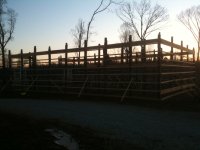scrimshaw33
Bronze Member
- Joined
- Sep 30, 2009
- Messages
- 81
- Tractor
- JD 4520 w/ cab and FEL
I'm making a very large pole barn out of hand hewn white oak beams (100 years old from four tobacco barns I salvaged) that are very heavy, probably 700 lbs each or more (?). They are 20 foot long on average. I've already got all the posts set 4 foot in ground with dirt tamped, but after a heavy rain and some wind the poles still are moving laterally even with reinforcement from 2x6 girts. I don't have the roof trusses up yet. One thing I haven't done that I'm going to do is place a cross base at each corner and perhaps place a cross member between each post.
For the post holes I placed a 6 inch pad of concrete slab at base, and again I tamped hole with dirt around post.
My question is, would I rot the post if I dug around each post individually about 2 foot down and placed concrete to reinforce the posts, or is this just not necessary and is the lateral movement normal without the trusses? I would really feel more comfortable with the concrete around the posts but have read differing accounts as to whether it will rot the posts or not.
I've also considered using cables run from the corners inward to meet in the middle of each wall, separately down to a anchor. Any other ideas?
For the post holes I placed a 6 inch pad of concrete slab at base, and again I tamped hole with dirt around post.
My question is, would I rot the post if I dug around each post individually about 2 foot down and placed concrete to reinforce the posts, or is this just not necessary and is the lateral movement normal without the trusses? I would really feel more comfortable with the concrete around the posts but have read differing accounts as to whether it will rot the posts or not.
I've also considered using cables run from the corners inward to meet in the middle of each wall, separately down to a anchor. Any other ideas?

